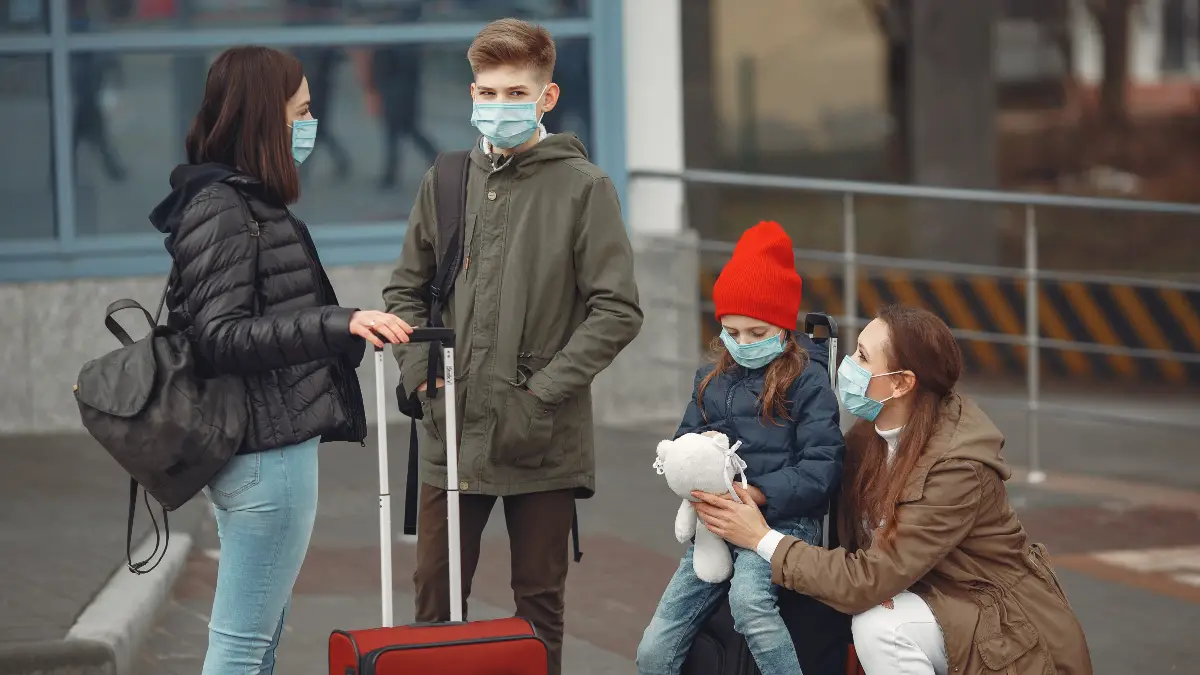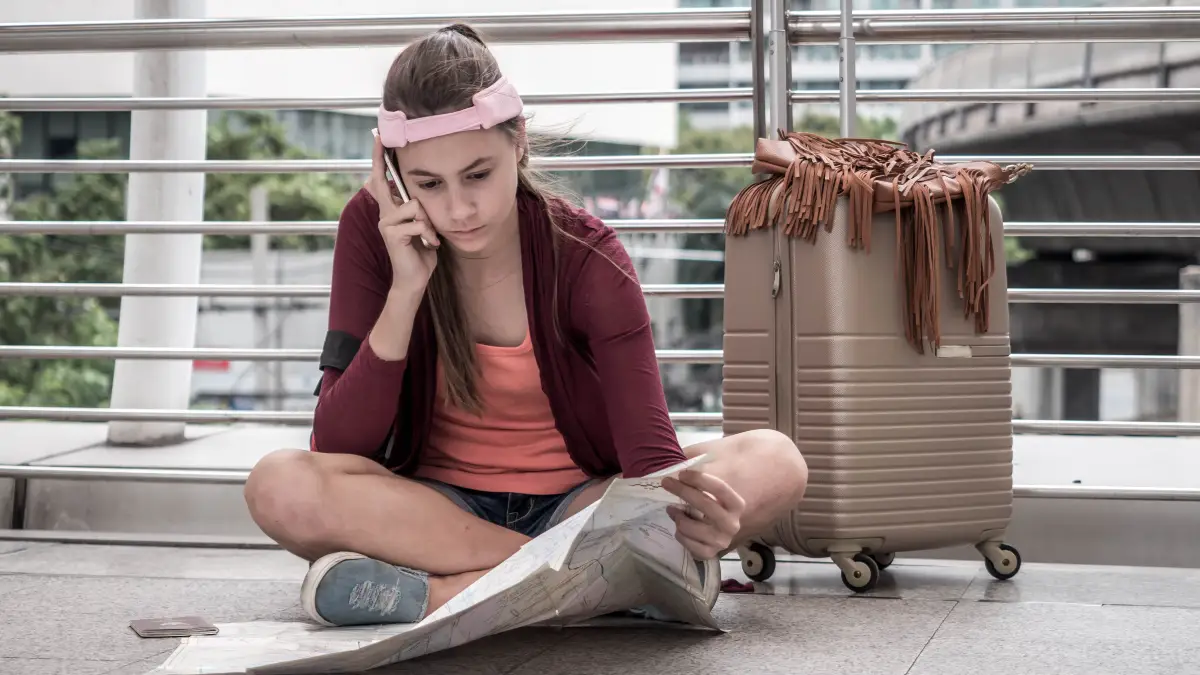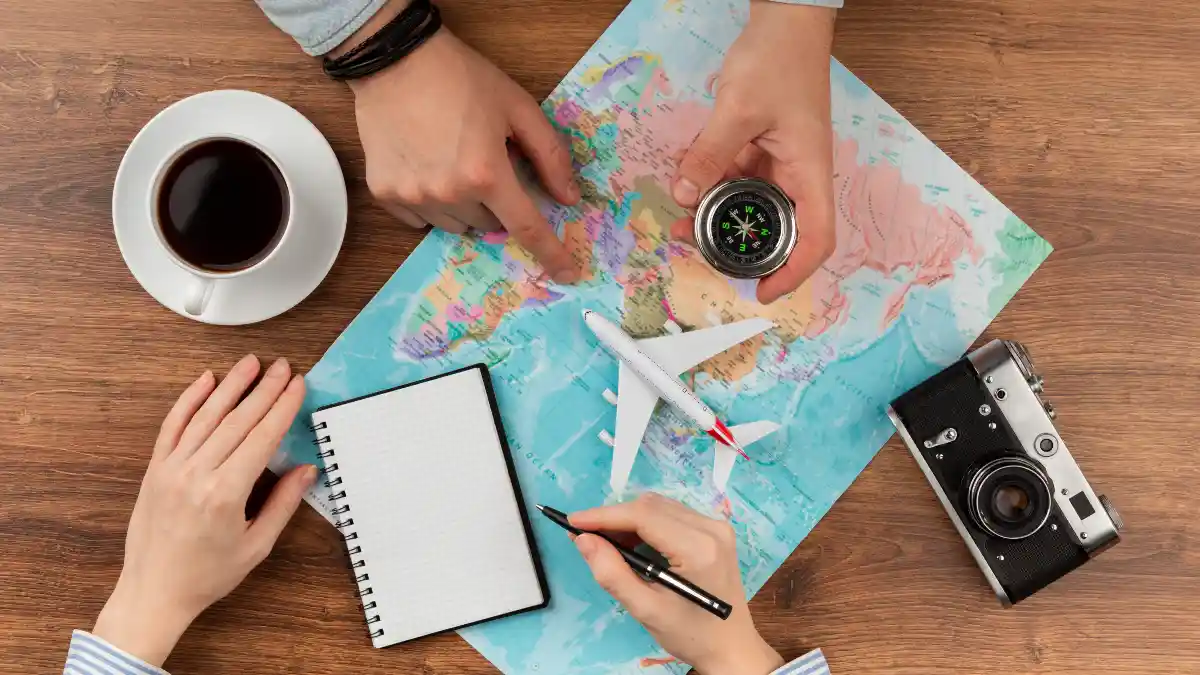That dream vacation you saved up for is starting to feel more like a nightmare, isn’t it? Your wallet is lighter, your patience is thinner, and the crowds are bigger than you ever expected.
The post-pandemic “revenge travel” party is officially over, and you’re stuck with the bill. That mad dash to make up for lost time pushed airports, hotels, and entire cities to their breaking point. The result? You’re paying sky-high prices for terrible service and fighting through mobs just to get a glimpse of the sights.
But this isn’t the end of great travel. It’s the end of traveling at any cost. This guide will show you exactly why your trips have become so chaotic and what’s coming next as the bubble bursts.
Why Everyone Rushed to Travel After the Pandemic

Why People Were Willing to Spend So Much
You’ve probably heard the term “revenge travel.” It describes the rush of people who wanted to make up for lost time and canceled plans after the pandemic. The idea was to “take revenge” on the pandemic by finally taking big trips.
People were ready to spend a lot on bucket-list vacations, relaxing getaways, and trips they had to postpone.
This strong urge to travel was backed by a lot of money. In Western countries, especially the U.S., people saved a lot of money during lockdowns. By August 2021, total savings in the U.S. hit about $21.1 trillion, which is like $8,000 for every person.
With a strong job market, many people were able and willing to spend big on travel to make up for missed experiences. The rise of remote work also meant more people could travel for longer and more often.
The main reason for all this was a simple desire to see family and friends again and get back to normal life. This changed how people thought about spending money on travel. A study of the U.S. airline market found something strange in 2022.
Many regular vacationers started acting like business travelers, who are usually less worried about price. For a while, the feeling of the trip was more important than the cost.
This allowed airlines and hotels to raise prices without losing customers. But that was temporary, and as savings ran out, people started paying attention to prices again.
The Numbers Behind the Travel Boom
The travel industry bounced back incredibly fast. In 2019, the world saw a record 1.46 billion international trips.
After a huge drop, the industry recovered to almost 90% of that level by 2023. In 2024, it matched the 2019 peak, with about 1.4 to 1.5 billion international trips. That was an 11% jump from 2023, or 140 million more trips in just one year.
This comeback had a huge economic effect. The travel and tourism industry was expected to add $11.1 trillion to the global economy in 2024.
That means 1 out of every 10 dollars spent worldwide was on travel. Money from international tourists hit $2 trillion in 2024, which was 14% more than before the pandemic in 2019.
The growth was so fast that it kept breaking records. According to Mastercard, nine of the last ten record-breaking spending days for cruises and airlines happened in 2024. A record 15.9 million Americans traveled overseas in the first three months of 2024.
At the same time, places like Japan saw over 3 million visitors in March 2024 alone. The recovery wasn’t the same everywhere.
Europe, the Middle East, and Africa saw more visitors than before the pandemic, while other regions were still catching up. Still, the big picture was a powerful and fast recovery.
How Revenge Travel Saved the Industry
For an industry that was hit so hard, this rush of travelers was a lifeline. Businesses that struggled during the pandemic—like airlines, hotels, and local shops—were saved by the flood of tourists. This spending brought back profits and created a lot of jobs.
The comeback was especially big for the hardest-hit parts of the industry. The airline industry, which lost half its value in 2020, made a huge turnaround. By 2023, its revenue was higher than before the pandemic.
Hotels and restaurants, which had been empty, were full of life again. This helped local businesses that supply them with goods and services, which was good for the whole community.
With so many people wanting to travel, businesses like hotels had “pricing power.” They could raise their rates to make up for money lost during the pandemic and deal with inflation.
Hilton’s CEO, Chris Nassetta, said that with high demand and not many new hotels, it was the perfect time to increase prices. Even with higher costs, people were eager to travel and willing to pay, which helped the industry get back on its feet.
The Problems with Too Much Travel

Popular Spots Became Too Crowded
The intense rush of revenge travel quickly overwhelmed the world’s most popular destinations. This brought back the old problem of “overtourism,” but this time it was worse.
About 80% of travelers visit only 10% of the world’s top tourist spots. This puts a huge strain on local services, annoys residents, and damages nature and historic sites. The travel frenzy was never going to last, either for you or for the places you visited.
You can see the results in Fodor’s annual ‘No List,’ which points out places with unsustainable tourism. The 2025 list has two types of destinations:
Places That Are Always a Problem:
These are spots that have struggled with too many tourists for a long time. In Bali, beautiful beaches like Kuta and Seminyak are now often filled with trash because the local waste systems can’t handle it.
In European cities like Barcelona, Venice, and Lisbon, the rush of tourists has made housing too expensive for locals, leading to protests against tourism.
New Hotspots at Risk:
The problem is also spreading to newly popular places. Albania’s visitor numbers grew from 3 million in 2015 to 10 million in 2023, and it’s now at risk of being overwhelmed.
Oaxaca, Mexico, has seen a 77% jump in tourism since 2020. This is straining public services like water and transportation and making local culture feel commercialized.
In response, many places are starting to fight back. They are putting new rules in place to manage the crowds and protect their communities.
Venice now charges an entry fee for tourists. Bali has a tourist tax to help the environment. Thailand limits the number of visitors to its islands, and Paris has stricter rules on short-term rentals to help with local housing.
You Started Paying More for Worse Service
One of the strange things about the revenge travel era was that you paid more for worse service. After getting a little better, customer satisfaction with the travel industry went down again.
The American Customer Satisfaction Index (ACSI) Travel Study for 2025 showed that people were less happy with airlines, hotels, car rentals, and online travel sites.
Airlines are a good example. While things like on-time flights got a bit better, the 2024-2025 Airline Quality Rating (AQR) was hurt by a big jump in customer complaints. This shows that travelers are tired of paying high prices for a bad experience.
Some airlines saw big drops in their scores. American Airlines’ score fell 8%, partly because of flight problems and changes to its loyalty program that people didn’t like. Southwest Airlines, on the other hand, improved its score by getting rid of change fees.
This drop in service quality is tied to a big labor shortage in the hotel and travel industry. A May 2024 survey found that 76% of hotels were still short-staffed, with housekeeping being the biggest problem.
Even though the industry has been adding jobs, there are still fewer people working in U.S. hotels than in 2019.
This means many hotels have to work with smaller teams, which makes it hard to give you the great service you expect, especially when you’re paying record-high prices. The result is a bad deal for you: paying more for less.
Why Airports and Flights Became a Mess
The revenge travel boom pushed the world’s travel system to its limit, leading to a lot of chaos. In 2024 and 2025, airports were often gridlocked, and flights were frequently delayed or canceled, especially during busy times like Thanksgiving.
This wasn’t just because of high volume; it was a crisis caused by years of problems and new challenges.
The issues are deep. The U.S. is short more than 2,800 certified Air Traffic Controllers (ATCs). This has forced the Federal Aviation Administration (FAA) to slow down air traffic to be safe, which causes delays across the country.
Old equipment makes things worse. Events like U.S. government shutdowns also cause problems. When TSA agents and ATCs have to work without pay, more of them call in sick, which adds to the staff shortages and messes up flight schedules.
The system is very fragile. In November 2024, the flight cancellation rate was five times higher than in November 2023, even before a big snowstorm hit. This showed the system had no room to handle unexpected problems.
You can also see the strain in smaller ways that affect your experience. For example, more people are using carry-on bags to avoid high checked bag fees.
This has led to a shortage of overhead bin space, which slows down boarding as gate agents have to check bags at the last minute.
The problem is so bad that airlines are thinking about new rules for the size and weight of carry-on bags, which would be another inconvenience for you.
Travel Just Got Too Expensive
The mix of high demand, high costs, and limited capacity led to “vacation inflation.” Things like high fuel and labor costs, a shortage of pilots, and the need for the industry to recover money lost during the pandemic all led to a big jump in travel prices.
In 2022, travelers were spending over 25% more on their trips than before the pandemic.
Data from the U.S. Travel Price Index (TPI) and the Consumer Price Index (CPI) shows how much prices have gone up. In August 2025, overall travel prices were about the same as the year before, but some things were much more expensive.
Airfares were up 3.3% compared to August 2024. Hotel room rates were down a bit from their 2024 peak but are still 16.9% higher than a decade ago.
The cost of eating out has gone up a lot, with restaurant prices rising by 50.1% over the last ten years. These rising costs are now a big concern for travelers.
This financial pressure is changing how people travel. The days of spending without a second thought are over.
You and other travelers are now looking for better value. Some people are taking shorter trips. Others are choosing cheaper domestic flights instead of expensive international ones.
This focus on cost marks the end of the revenge travel boom and the start of a new, more practical era of travel.
| Stress Factor | What It Looks Like | |
| Too Many Tourists | Tourist taxes in Venice (entry fee), Bali ($10 tax); Fodor’s “No List” includes Bali, Barcelona, Venice. | |
| Bad Service | Customer satisfaction score for Airlines drops to 76, Hotels to 76; Airline customer complaints are up. | |
| System Strain | U.S. is short 2,800+ air traffic controllers; Flight cancellation rate was 5x higher in Nov 2024 vs. Nov 2023 before a storm. | |
| High Prices | Airfare prices up 3.3% in a year (Aug 2025); Corporate hotel rates up 19% globally in the first half of 2025; Restaurant prices up 50.1% in a decade. |
The Bubble Bursts: What’s Changing Now

People Won’t Pay Crazy Prices Anymore
Because of all the system stress, bad service, and high prices, the “revenge travel” era is over. The bubble has burst. This doesn’t mean people have stopped wanting to travel. It’s a needed correction in how people plan and what they expect.
Many industry reports now say that “revenge travel is a thing of the past”. The wild phase, driven by saved-up money and a desire to get out, has been replaced by a more careful and practical way of planning trips.
You can see this change in the official forecasts for 2025. The U.S. Travel Association predicts a 6.3% drop in international visitors for the year—the first drop since 2020.
The global travel market is still expected to grow, but at a much slower and steadier pace than in the last few years.
The reason for this is a new mindset. You and other travelers are no longer willing to travel at any cost. High prices for everything have made people more careful with their money.
Now, finding good value is a top priority when choosing a destination. This is especially true for travelers from Europe and North America, who are planning to spend less on travel or stay closer to home to save money.
| Characteristic | “Revenge Travel” Era (2022-2024) | “Intentional Travel” Era (2025 and After) |
| Main Reason to Travel | Making up for lost time; “taking revenge” on the pandemic. | Looking for real experiences, wellness, and connection. |
| Where to Go | Bucket-list, famous spots, no matter the crowds. | Less-known places, “destination dupes,” avoiding crowds. |
| How People Spend | Willing to spend a lot of saved money; not worried about price. | Careful with money, looking for value, sticking to a budget. |
| Top Priorities | Big spending, luxury, checking places off a list. | Sustainability, self-care, quality over quantity. |
| Feeling About Crowds | A necessary evil to see famous places. | Something to avoid; “quiet life travel” is the goal. |
Travelers Have New Priorities
As the urge for revenge travel disappears, a more thoughtful way of traveling is taking its place. The market is shifting from “revenge travel” to what people are calling “intentional travel”.
This new approach is about having meaningful experiences instead of just buying things or checking boxes on a list. This change is based on a few key ideas that are shaping what travelers want.
First, there’s a bigger focus on sustainability. Eco-friendly travel is no longer a small trend; it’s something that now affects your travel choices.
More travelers are choosing businesses that care about the environment and places that try to limit their negative impact.
Second is a desire for authenticity. Instead of buying mass-produced souvenirs, you might be looking for real cultural experiences.
This could mean taking a cooking class, visiting a local workshop, or finding a dive bar with a great band that only locals know about.
Third, wellness and self-care are now major reasons to travel. Many trips are now focused on personal well-being.
This can be anything from a relaxing beach trip to a “longevity retreat” designed to help you live longer, which 60% of travelers said they were interested in. Simple things like stargazing trips to places with dark skies are also becoming popular ways to relax and recharge.
Where People Are Traveling Instead
The problems of the revenge travel boom—overcrowding and high prices—have led to new travel habits that are changing the tourist map. These trends are a smart response to the failures of the old way of travel.
The biggest trend is the “destination dupe.” You and other travelers are swapping famous, crowded hotspots for less-known places that offer a similar vibe for less money and with fewer people.
This trend, which has over 400,000 posts on social media, is a direct reaction to the bad experience at popular spots. For example, instead of crowded Santorini, you might choose the beaches of Paros.
Instead of Italy, you might visit the coast of Albania. Instead of Hawaii, you could explore the Azores , or visit the cave city of Matera, Italy, instead of Cappadocia, Turkey.
This is a popular way to get a better travel experience. It helps reduce the pressure on crowded cities and brings money to new places.
Another trend is “quiet life travel,” where you choose to avoid crowds completely. Searches for “quiet life” on Pinterest have gone up by 530%.
This shows up in a few ways: 63% of travelers say they are likely to visit a less-popular destination on their next trip, and many are traveling in the off-season to avoid the biggest crowds.
Finally, high prices are making people rediscover places closer to home. The rising cost of things like gas and groceries, plus expensive flights, are making long trips difficult for many.
Because of this, domestic road trips increased by 30% in the spring of 2025, and 54% of travelers said they plan to drive instead of fly on their next vacation. This helps smaller cities, national parks, and other local spots that might have been ignored in the past.
What to Expect from Travel in 2025 and Beyond

Slower Growth and New Risks on the Horizon
As the travel industry moves past the bubble, the forecast for 2025-2026 is for slower, more stable growth, but with some big risks. Phocuswright expects the global travel market to keep growing through 2026, but at a calmer pace of 6-9% per year.
UN Tourism also predicts 3-5% growth in international arrivals for 2025. In the Asia Pacific region, a strong comeback is expected to continue, with visitor numbers possibly reaching 813.7 million by 2027.
The next big wave of growth, especially for travel to the U.S., will likely come from a “mega-decade” of major events.
This includes the FIFA World Cup in 2026, America’s 250th anniversary, the 2028 Summer Olympics in Los Angeles, and other big sporting events. These all have the potential to bring in a record number of international visitors.
However, there are some serious challenges that could slow things down. High transportation and hotel costs are still a major problem. Political instability around the world is also a big concern.
A potential trade war between the U.S. and China could create a lot of uncertainty. A new U.S. administration could also change policies on tariffs, airlines, and visas, which would affect travel to the U.S. and could cause other countries to react.
There’s also the risk of a global recession, which would mean less travel for both business and pleasure.
This creates a tricky situation for the industry. While you might be looking for quieter, more sustainable trips, the industry’s next big growth drivers are huge events that create crowds.
The future of travel will depend on whether destinations can handle these big events without creating the same old problems of overcrowding and chaos.
Who Is the New Post-Pandemic Traveler?
The traveler of 2025 is different from before the pandemic. They are more diverse, careful, and comfortable with technology. If you’re a travel business, you need to know these new types of travelers.
The Solo & Remote Traveler:
Traveling alone is becoming more common, especially for younger people. Surveys show that 76% of Millennials and Gen-Z plan to take a solo trip, often focused on self-discovery.
This is linked to remote work, which lets people mix work with long-term travel.
The Multigenerational Family:
Family trips now often include grandparents. With 77 million Americans turning 65 over the next 18 years, grandparents are a big part of leisure travel.
Over 50% of parents say they are planning trips with both their parents and their kids.6In these families, kids often have a big say in where the family goes on vacation.
The Event-Driven Tourist (“Gig Tripper”):
Big cultural events like Taylor Swift’s “The Eras Tour” have made event-driven travel a huge trend. You might plan an entire vacation around a concert, a big sports game, or even a natural event like a solar eclipse or meteor shower.
These events give people a strong reason to travel and bring a lot of money to the host cities.
The Wellness Seeker & Digital Detoxer:
Taking care of your well-being is now a top reason to travel. This can mean “glow-cations”—trips for skincare treatments—or retreats focused on living a longer, healthier life.
At the same time, some people are “dead zoning,” which means choosing destinations where it’s easy to unplug from work and screens to get a real mental break.
How to Find Good Deals Now
To serve the new type of traveler and handle the post-bubble market, the travel industry is changing. It’s using a mix of human experts and new technology.
The Return of the Human Expert:
With so many choices and so much uncertainty, you might be turning back to travel agents. About 76% of travel agents say they have more work now than before the pandemic.
Google search interest for travel agents in 2024 was the highest it’s been since 2005. This shows people want expert help to plan unique and real trips.
AI as Your Travel Helper:
Artificial intelligence (AI) is quickly becoming a key tool for travel. AI tools can help you plan trips, give personalized suggestions, and make things run more smoothly. You can use AI to map out a scenic drive or find a destination that fits a certain vibe.
For the industry, AI can help with everything from setting airline prices to personalizing your hotel stay.8 About 50% of travelers expect to use AI to help plan their trips soon.
More Personalization:
The old one-size-fits-all model is gone. Airlines and hotels are moving to systems that let you pick and choose what you pay for.
This means you can buy just the specific things you want, like a certain seat on a plane or a late check-out from your hotel. This creates a more custom trip that fits what you’re looking for.
Finding Value in the New Market:
If you’re trying to save money, you need a smart approach. Experts say you should book flights at specific times—usually 1 to 3 months ahead for domestic trips and 2 to 6 months for international trips—to get the best prices.
Being flexible is the best way to save. Flying on cheaper days like Wednesdays and Saturdays can save you a lot of money.
Using apps and websites like Skyscanner, Hopper, and Google Flights to track prices and get alerts is now a common way for smart travelers to find deals. Finally, bundling your flight, hotel, and car rental into a package can often get you discounts you can’t get by booking them separately.
What This Means for Your Future Trips
The bursting of the revenge travel bubble was messy, but it was a needed correction. The wild rush of travel after the pandemic showed all the weak spots in the global travel system, from old infrastructure and staff shortages to the serious problems of overtourism.
When you and other travelers pushed back against high prices, bad service, and huge crowds, it wasn’t because you didn’t want to travel. It was because the old way of doing things was broken.
The shift from “revenge” travel to “intentional” travel offers a path to a better future. The new trends—like responsible tourism, the search for real experiences, the move to “destination dupes,” and the demand for personalized, value-driven trips—are not just passing fads.
They are the building blocks of a new travel economy. The challenge for the industry is to accept this new reality. To succeed, it will need to balance growth with responsibility and efficiency with good service. The frenzy is over.
The era of thoughtful, intentional travel has begun. This could lead to a system that is healthier for the planet, for local communities, for the industry, and for you.


